Exploring Surfboard Surfing: Techniques and Impact


Intro
Surfing isn’t just a sport; it’s an experience that intertwines an individual’s skill with nature’s might. The ocean, an unpredictable companion, offers waves that not only demand respect but also a choicely crafted surfboard. For both novice and seasoned surfers, understanding the nuances of surfboard surfing morphs from an abstract curiosity into a tangible necessity. If one is to navigate this watery playground, knowing the gear, maneuvering techniques, and cultural influences becomes paramount.
In this article, we will embark on an exploration of surfboard surfing, diving into its historical contexts, essential gear, techniques for skill enhancement, safety practices, and how the sport interacts with contemporary culture. We will also take a moment to reflect on the environmental challenges facing the sport and what the future may hold. Through this journey, every wave we ride will reveal insights about what this unique community represents and how it adapts amidst changing tides.
Gear Recommendations
Essential Gear for Beginners
For those just starting their surfing journey, choosing the right gear can feel daunting. Here’s a simplified guide of must-have items that can help transform the learning experience:
- Surfboard: As a beginner, a soft-top surfboard is often recommended. These boards are more forgiving and reduce the risk of injury.
- Wetsuit: Depending on your local waters, investing in a wetsuit can keep you warm and safe from harmful elements. Choose a suit that provides a snug fit without restricting movement.
- Leash: This essential piece keeps your board close, preventing it from getting lost amid waves.
- Wax: Using surfboard wax enhances grip, minimizing the chances of slipping off the board as you try to ride a wave.
Advanced Equipment for Professionals
For the surf veterans seeking to elevate their prowess, advanced gear becomes a crucial element. Here are some tools that can further refine one’s surfing technique:
- Performance Shortboards: Designed for speed and maneuverability, these boards often feature thinner profiles and sharper rails, perfect for executing tricks and handling steeper waves.
- Custom Wetsuits: Tailored to individual measurements, these suits can enhance flexibility and thermal protection, giving an edge in cooler waters.
- High-Quality Fins: The right fins can make a world of difference in how a board performs. Experienced surfers often experiment with different fin set-ups to find what complements their surfing style.
- Surfboard Leashes with Quick Release: For those deeper stunts or big wave riding, a quick-release leash can help avoid entanglement in dangerous situations.
Techniques and Tips
Skill Improvement Strategies
Enhancing surfing skills often extends beyond just practice. Here are some effective strategies:
- Observation: Spend time watching more experienced surfers. Notice how they position themselves, paddle, and choose waves.
- Video Analysis: Record your sessions and analyze your performance. This reflection can be invaluable for spotting areas to improve.
- Regular Drills: Incorporate exercises that target balance and core strength, crucial for maintaining stability on the surfboard.
Safety Practices and Guidelines
Safety is a big part of surfing, and adhering to certain practices can prevent mishaps:
- Know the Tide and Weather: Always check surf conditions and potential hazards.
- Respect Local Etiquette: Understanding the rules of the surf spot and the community can avoid conflicts.
- Surf with Purpose: If conditions seem beyond your capability, it’s wiser to sit out than to force a session.
A knowledgeable surfer knows that safety is as vital as skillfulness; one does not outpace the ocean without respect.
Historical Context of Surfboard Surfing
Understanding the historical context of surfboard surfing is vital for appreciating how the sport has evolved and flourished over time. From its humble beginnings to its status as a global pastime, every surfer today stands on the shoulders of those who paddled out before them. The historical narrative of surfboarding not only sheds light on the techniques and equipment used but also illustrates the cultural implications attached to riding the waves.
Origins of Surfboarding
The roots of surfboarding trace back to ancient Polynesian cultures, where the ocean was revered not just as a source of sustenance but as a vital part of the community’s lifestyle. Historical texts and artifacts suggest that surfboards, or olo for chiefs and paipo for commoners, were crafted from local wood, making them both functional and a symbol of social status.
There’s a rich tapestry of tales surrounding the arrival of surfboarding in the Hawaiian Islands, where it was woven into the very fabric of the culture. In the early 19th century, it became common for Hawaiian chiefs to showcase their skill and dominance over the waves, solidifying surfing’s connection to identity and tribal heritage.
"Old Hawaiian proverb: "The ocean is the embodiment of all knowledge." This statement encapsulates the deep relationship between the people and the water, signaling that surfing is about more than just sport—it’s also a spiritual connection."
Evolution Over the Decades
As we move from the historical origins, it's interesting to see how surfboarding has changed over the decades. In the early 1900s, surfboards were long, heavy wooden planks, a far cry from what one would encounter today. The introduction of lighter materials after World War II, particularly foam and fiberglass, revolutionized board design, allowing for advanced techniques and more maneuverability.
The 1960s marked a pivotal moment in the surf culture landscape with the emergence of surf films and competitions, which played a crucial role in popularizing the sport globally. Following that, we saw the rise of shortboards in the 1970s, reshaping surfing techniques and giving birth to tricks that we often take for granted today. This decade also witnessed the emergence of a diverse surfing community that celebrated personal expression and style, alongside the competitive nature of the sport.
Cultural Significance in Global Watersports
The cultural significance of surfboarding stretches far beyond any single region or community. Surfing has become a universal language—connecting people from varying backgrounds under shared experiences on the beach and the thrill of catching a wave.
In contemporary times, surf culture embodies aspects such as freedom, self-expression, and connection to nature. International surfing competitions showcase not just athletic prowess, but also a dedication to the environment, pushing forth notions of sustainability in many surf communities.
Moreover, as surfing continues to infiltrate popular culture—through films, fashion, and art—it serves as a reminder of the deep connection between humanity and the ocean. People draw inspiration from the sport not only for competition but for a lifestyle yearned by many as a retreat from the pressures of daily life. It allows for a harmonious interaction with nature, which becomes ever more significant in today’s fast-paced, urban world.
As we dive deeper into the other sections of this exploration, it becomes clear that understanding the historical context of surfboard surfing enriches our appreciation of the sport's depth, diversity, and significance in a global arena.
Surfboard Varieties and Their Characteristics
When it comes to surfboarding, the type of board can seriously affect your experience in the water. Each variety has its own set of characteristics, shaping the way a surfer rides the waves and interacts with the ocean's forces. This section explores the different types of surfboards, their perks, and considerations, catering to a spectrum of surfing styles, skill levels, and personal preferences.
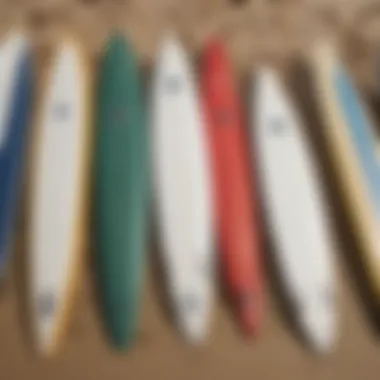
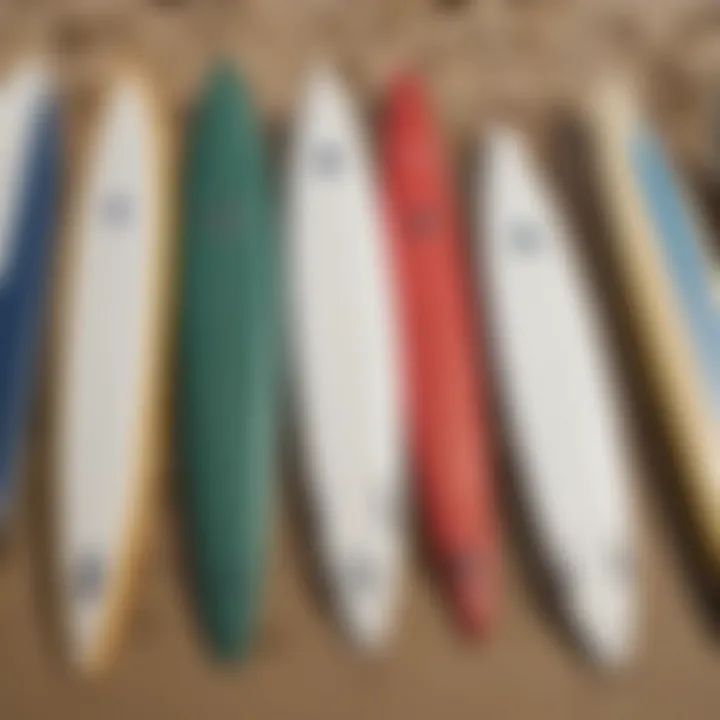
Shortboards versus Longboards
Shortboards and longboards represent the yin and yang of surfboarding. Shortboards, with lengths typically between 5 to 7 feet, are designed for speed and agility. They provide a responsive feel, ideal for advanced surfers who fancy tight turns and quick maneuvers. If you love hitting the lip and performing tricks, a shortboard could be your best friend. However, these boards can be quite tricky to balance on, especially for newbies.
In contrast, longboards exceed 8 feet in length, offering a stable platform. They're perfect for beginners or those who prefer a more laid-back riding style. Longboards excel in cruising and drawing smooth lines on smaller waves. It's like the difference between a sports car and a classic cruiser; both have their charm, yet tell different stories on the same road.
"Choosing the right board is like finding the right pair of shoes; it should fit your style and the terrain of your journey."
Before picking, consider the kinds of waves you'll be riding and your personal skill level. Longboards can be enticing for their ease but don’t underestimate the thrill of a shortboard once you get the hang of it.
Fish and Funboards
Fish and funboards add a bit of flair to your surfboard options. Fish boards, characterized by their unique swallow tail design, provide a fun twist on the traditional shortboard format. Generally shorter and wider than standard shortboards, they excel in smaller surf conditions. Their design aids in speed and maneuverability, making them a crowd favorite for surfers hunting for a bit of fun while gliding along the face of a wave.
On the other hand, funboards fill the gap between shortboards and longboards, typically ranging from 7 to 8.5 feet. They are designed for versatility, offering a balance between stability and nimbleness. Funboards are particularly advantageous for those who are beginning to master their skills, bridging the gap between paddle power and responsiveness. If you're unsure of what kind of board to invest in, funboards can be a wise choice due to their adaptability across different wave conditions.
Consider what you want from your surfing experience. If you are looking to explore various aspects of the sport, fish or funboards may serve you well.
Material Choices: Foam, Epoxy, and Wood
The materials used in surfboard construction directly impact performance and durability. Foam surfboards, particularly those made with expanded polystyrene (EPS), are celebrated for their lightweight properties. They provide excellent buoyancy, making them ideal for beginners. Foam boards are also known for their soft top surfaces, reducing the risk of injury when attached to a novice's surf skills.
Epoxy boards, a step up from traditional fiberglass, offer strength and increased buoyancy. They tend to be lighter and more durable than their polyester counterparts. Surfers who favor speed and longevity might lean towards epoxy, as these boards puncture less easily and resist the wear and tear of saltwater conditions.
Wooden boards, while less common today, offer a unique aesthetic and are often favored by traditionalists. They evoke a sense of nostalgia and craftsmanship; made from higher quality woods, they provide a beautiful ride. While not as prevalent in the modern surf scene, wood boards represent a rich history and artistry in surfboard making.
Understanding these materials can help you select the best option according to your needs, whether that be guidance for learning or performance for advanced riding.
Technical Aspects of Surfing Techniques
Understanding the technical aspects of surfing techniques is essential for anyone looking to improve their skills in the water. These techniques lay the groundwork for maximizing performance and experiencing the thrill of surfing on different types of waves.
Mastering the art of paddling, the mechanics of popping up, and the various turning techniques not only enhances one’s surfing ability but also contributes to safety and enjoyment during sessions. A solid grasp of these fundamentals allows surfers to adapt to changing conditions and navigate various surf environments with ease.
Paddling: The Foundation of Surfing
Paddling is the very lifeblood of surfing. Before you can even think about catching waves, you need to get yourself out there, and that requires effective paddling skills. This is where strength, technique, and endurance come into play.
Good paddling technique involves finding the right body position on the surfboard. Lying too far back can lead to a lack of speed, while lying too far forward might cause the nose to dive. The correct stance allows the surfer to glide through the water with minimal drag, making it easier to reach the lineup.
In addition, using a strong arm stroke while maintaining a steady rhythm is crucial. This is not just a workout for the arms but also engages the core muscles, promoting stability and control. Moreover, making efficient use of a kick with your legs, while paddling can help in generating more speed.
Pop-Up Mechanics
The pop-up is more than just a fancy maneuver; it's a critical skill every surfer must master. Getting from lying on the board to standing up in one smooth motion can be the difference between getting a good ride and crashing into the water face first.
When popping up, timing is everything. Surfers should initiate the pop-up as they feel the wave lifting the board. This crucial moment demands quick reflexes and confidence. The hands must push off the board while the back foot quickly finds its place near the tail. Meanwhile, the front foot follows through, maintaining balance.
Practicing this motion on land is a common technique for surfers, allowing them to become more familiar with the necessary muscle movements before hitting the water. With enough repetition, the pop-up can become second nature, enabling surfers to seize every opportunity to ride the wave.
Turning Techniques: Carving and Snap Turns
Turning is an essential skill in surfing, providing the ability to change direction while riding a wave. There are different styles of turning, but two important techniques are carving and snap turns. Both require different approaches but are equally vital for mastering the surf.
Carving involves making broad, smooth arcs on the wave face. This style allows for maintaining speed while maneuvering and is best suited for power turns, especially on open faces. Surfers shift their weight onto their back foot, applying pressure to the edge of the board to carve through the water gracefully. The key here is to maintain balance by digging the rail in while relaxing the upper body to steer the board smoothly.
On the other hand, snap turns are sharper and more aggressive, designed for abrupt changes in direction. These turns create eye-catching spray and are often used to blast off the top of a wave. To execute a snap, the surfer needs a burst of power, quickly shifting weight and using the back foot to pivot the board around. Timing is again crucial, as snap turns usually occur at the peak of the wave, taking advantage of its height.
A good blend of both techniques enhances a surfer’s ability to navigate different wave conditions effectively. Each turn—whether carving or snapping—exhibits a surfer's style and enhances their overall surfing experience.
"The ocean is like a great teacher; each wave is a lesson waiting to be learned"
Understanding these technical aspects is pivotal for anyone wanting to progress in surfing. Staying aware of one’s technique means the difference between a surf session that leaves you wanting more rides and one that feels like a chore.
Safety Practices in Surfboard Surfing
When it comes to surfboard surfing, safety isn't just a suggestion; it's a necessity. The ocean can be unpredictable, and practicing safe surfing can mean the difference between a thrilling day on the waves and a serious accident. A solid understanding of safety practices prepares surfers to navigate risks effectively. Here, we’ll dive into several key practices that are crucial for anyone looking to enjoy this exhilarating sport.
Understanding Surf Conditions
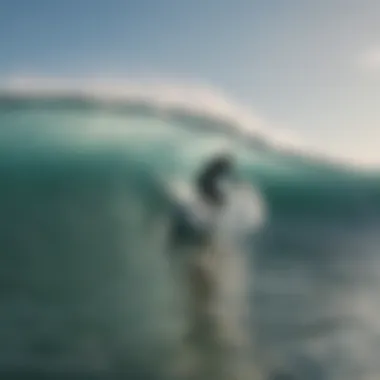
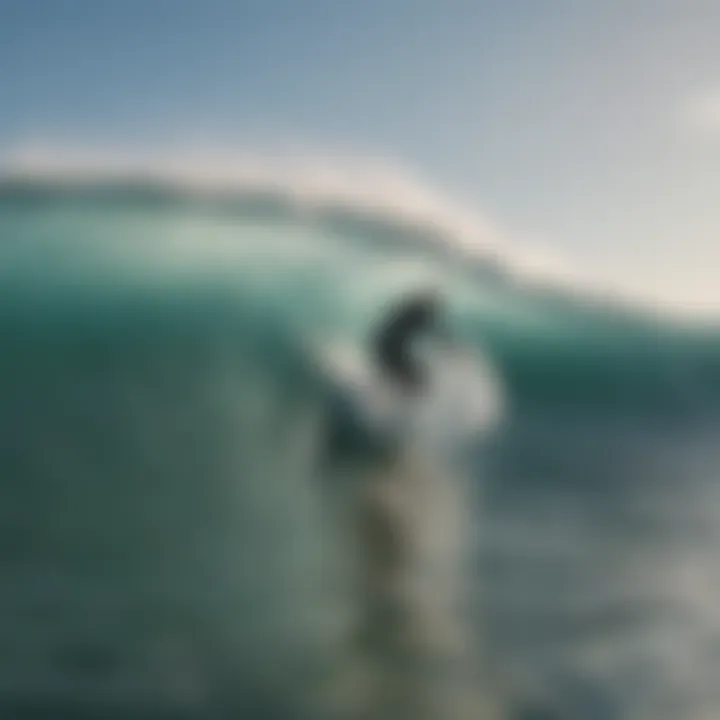
Before paddling out, it's essential to grasp the surf conditions. This knowledge allows surfers to assess whether it's a good day for surfing or if it's better to sit the session out. Key elements to consider include:
- Wave height and frequency: Large waves may look enticing, but they can pose dangers, especially for beginners.
- Tide levels: Hardly any experience matters if the tide is coming in or going out. Some breaks work best at specific tide conditions.
- Current patterns: Rip currents can be particularly menacing and understanding how to spot and avoid them is vital.
- Weather conditions: Squalls can arise quickly, altering the surf conditions and making it unsafe.
Keeping an eye on these aspects not only enhances your surfing experience but also ensures your safety and the safety of fellow surfers.
Personal Gear for Safety
Wearing the right gear can significantly reduce the risk of injuries while surfing. Here’s a rundown of essentials:
- Wetsuits: Depending on the temperature of the water, a wetsuit helps maintain body heat, but more importantly, it can protect against abrasions from the surfboard or reefs.
- Leashes: A leash keeps the board tethered to the surfer, which helps prevent the board from becoming a hazard to others in the water.
- Rash Guards: These can help prevent skin irritation and sunburn, which is especially important for surfers who spend long hours under the sun.
- Helmets: Though not widely used, some surfers in high-impact areas opt for helmets to protect themselves from wipeouts and collisions.
It’s important to recognize that even the most seasoned surfers still prioritize the use of supplemental gear. Choosing the right personal gear not only promotes safety but also enhances overall confidence in the water.
Injury Prevention Strategies
No one wants to end their surfing session with an injury. A few strategies to keep yourself in one piece include:
- Warm-Up and Stretching: Preparing your body beforehand helps avoid strains or sprains when paddling or popping up on the board. Simple stretches targeting arms, legs, and back are effective.
- Stay Aware of Surroundings: Keeping an eye out for other surfers, rocks, and marine life can prevent many close calls. Always be conscious of where everyone is in relation to your positioning in the water.
- Know Your Limits: It’s crucial to understand your skill level. Pushing too hard can lead to falls and possible injuries. Always take the time to understand the wave dynamics and the overall surf environment before taking on complex maneuvers.
- Learn Basic First Aid: Having some knowledge of first aid can be indispensable when in the water. Knowing how to handle common injuries can save precious time and facilitate a quicker recovery.
By adhering to these safety practices and being mindful of the environment, surfers can enjoy the perks of riding the waves while minimizing risks. Surfing is about flow and freedom, but that doesn't mean we should lose sight of safety.
Environmental Considerations in Surfboard Surfing
Understanding the Environmental Considerations in Surfboard Surfing is vital, especially in today's context where ecological awareness has become paramount. The balance between enjoying the waves and preserving oceanic health is delicate. Each surfer, whether a novice or seasoned pro, plays a part in maintaining the very foundations of their beloved sport. Hence, addressing the environmental impact of surfing practices and decisions is not just an option; it's a responsibility.
Impact on Marine Ecosystems
Surfing inherently interacts with marine ecosystems. The impact can be profound, with pollution from surfboards, wetsuits, and accessories affecting water quality, marine life, and coastal areas. Common pollutants include:
- Chemical residues: Many surfboard manufacturing processes involve harmful chemicals, such as resin and paints, which can leak into water bodies.
- Plastics: Surfing gear often includes plastic components that, when discarded irresponsibly, contribute to ocean trash, suffocating marine wildlife.
Moreover, overcrowding at popular surf spots leads to habitat degradation. The thrashing of fins against coral reefs can cause irrevocable damage to these ecosystems. Conservation efforts undertaken by local surfing communities can mitigate these impacts, such as advocating for cleaner practices and participation in beach clean-up initiatives.
"Every surfer has a stake in preserving clean, vibrant oceans. The waves you ride today shape the waves of tomorrow."
Climate Change and Surfing Conditions
Climate change is transforming the oceanic playgrounds surfers adore. Temperature shifts affect wave patterns and surf breaks, making specific spots less predictable or even unusable. Key considerations include:
- Rising sea levels: Increased water levels might alter coastal geology, affecting how and where waves break.
- Ocean acidification: Higher carbon dioxide levels are changing seawater chemistry, leading to challenges in coral growth and overall marine health, which ties back to wave integrity.
- Changing weather patterns: Altered rainfall and storm frequency can modify how waves form and their intensity.
Understanding these changes allows surfers to adapt and anticipate new challenges, while also promoting environmental stewardship within the sport.
Sustainable Practices for Surfers
Surfers possess unique opportunities to utilize sustainable practices that not only enhance their experience but also protect the environment. Here are tangible actions anyone can take:
- Choose eco-friendly surfboards: Brands like Firewire or sustainable surfboards focus on using recycled materials or organic resins.
- Participate in local clean-ups: Joining community efforts to clean beaches fosters a commitment to environmental health.
- Mind your waste: Use reusable water bottles and avoid single-use plastics to minimize pollution.
- Educate yourself: Staying informed about local ecosystems and how surfing affects them can empower surfers to make smarter choices.
By integrating these considerations into their practices, surfers can become stewards of the ocean, advocating for a healthier marine environment while enjoying the thrill of riding the waves.
Comparative Analysis: Surfing Regions
When diving into surfboard surfing, understanding the unique characteristics of various surfing regions becomes vital. Each location is influenced by a multitude of factors including geographical features, wave patterns, and local culture. A comparative analysis of these regions offers insights that can enrich a surfer’s experience, ensuring the right choice of destination based on skill level, wave type, and environmental considerations.
The Big Wave Surfing Arenas
Big wave surfing is not for the faint-hearted. Locations like Waimea Bay in Hawaii and Jaws on Maui are celebrated havens where surfers tackle colossal waves exceeding 30 feet. The thrill of conquering such waves is mixed with respect for the ocean's power. Safely navigating these waters requires not just experience but also a keen understanding of the tides and weather patterns. It’s crucial for surfers to recognize that these spots come with significant risk—factors like local currents and hidden reefs pose dangers.
"Catching a big wave is like dancing with nature; it requires commitment, respect, and a touch of bravery."
Getting familiar with the topography of these arenas can dramatically impact a surfer's performance. The mechanisms of waves here are complex; they can change with the wind and the time of year. Optimal conditions for big wave surfing often occur during winter months, making spot checks critical for enthusiasts.
Family-Friendly Surf Spots
On the flip side, family-friendly surf spots cater to novice surfers and families looking for a relaxed introduction to the sport. Places like Kailua Beach in Hawaii and Long Beach in California are perfect examples. These areas have gentler wave conditions and sandy bottoms, making them suitable for younger surfers and those still learning the ropes.
Visiting these locations often involves learning schools that provide lessons, rental gear, and safety guidelines. The atmosphere is less about competition and more about enjoying the waves together. Facilities such as board rentals and lifeguards are usually readily available, enhancing the safety and enjoyment of those who may be unfamiliar with the ocean's dynamics.
- Benefits of Family-Friendly Spots:
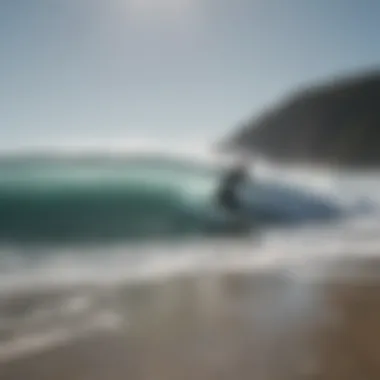
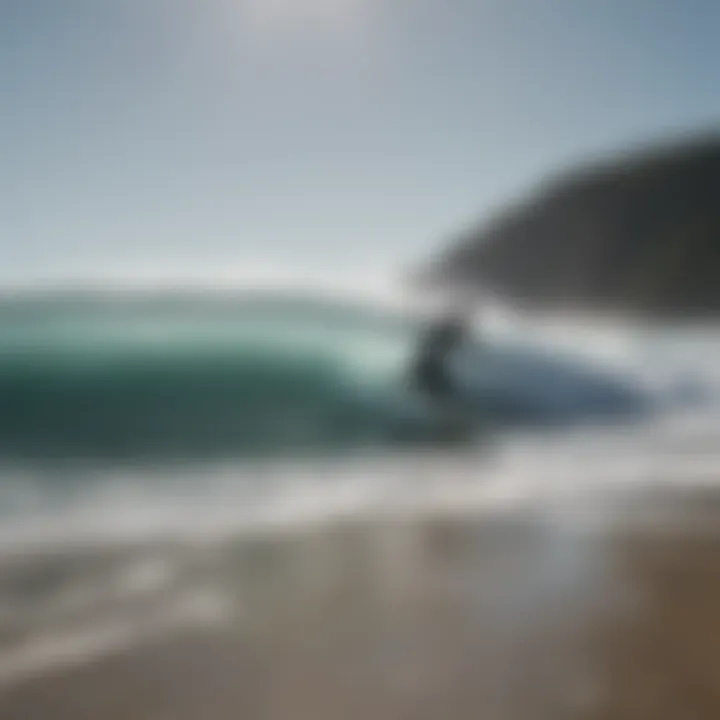
- Soft, manageable waves
- Safety facilities in place
- Available surf instructors for beginners
- Relaxed atmosphere fostering family time
Challenging Surf Breaks for Experts
For seasoned surfers seeking to push their limits, expert-level breaks like Mavericks in California present formidable challenges. The waves here are powerful and break in unpredictable ways, requiring not just skill but advanced techniques and strategy. Mastering these waves involves pinpointing the right moment to drop, maneuvering through rough waters, and safely exiting.
Moreover, factors such as seasonal variations and swell direction can dramatically alter surfing conditions, making it imperative for expert surfers to stay informed. The camaraderie among local surfers often serves as an invaluable resource for those looking to fully understand the intricacies of these spots. This sense of community not only encourages safety but also enriches the surfing experience through shared stories and tips.
- Key Considerations for Expert Breaks:
- Stay updated on weather and tide changes
- Understand local rules and customs
- Build connections with other surfers for knowledge exchange
In summary, a comparative analysis of surfing regions highlights the diversity of surfing experiences available across the globe. Whether it’s riding giant swells in challenging arenas, enjoying gentle waves with family, or honing elite surf skills in competitive breaks, each location offers its own unique allure. Choosing the right region will not only boost confidence but also enhance the joy of surfing altogether.
Cultural Perspectives on Surfing
Surfing is more than just a sport; it’s a cultural phenomenon deeply woven into the fabric of coastal communities around the world. In this section, we'll explore how surfing shapes social interaction, influences gender roles, and impacts local economies. Understanding these cultural perspectives can empower surfers to connect with their roots and recognize the broader implications of their beloved sport.
Surfing Communities: A Social Fabric
The surfing community is a patchwork of diverse individuals, united by their passion for the waves. These local tribes often revolve around specific beaches, creating a unique social infrastructure. It's not just about riding waves; it’s about camaraderie and a shared experience. Members often support each other in honing their skills, sharing tips, and even looking out for one another’s safety.
Community events, surf schools, and local competitions serve to strengthen this bond. Surfing clubs also play a pivotal role in nurturing new talent and fostering an inclusive environment. This social fabric is especially evident in places like Hawaii, where surfing is regarded as a cultural practice, passed down through generations, celebrated with festivals and gatherings that bring surfers together in joyous community spirit.
"Surfing taught me that it's not just about the sport but about the family you build around it."
For many, these relationships not only enhance the surfing experience but also offer a sense of belonging. Individuals who may feel isolated in their daily lives often find community and support within these social circles, turning surfing into a holistic lifestyle.
Gender Dynamics in Surf Culture
The narrative of surfing has historically been male-dominated, yet the tides are shifting. Female surfers are carving out significant space in the surfing world, breaking stereotypes and reshaping the cultural landscape. Women are thriving in competitive environments, gaining recognition and respect among peers. Female surfing legends like Lisa Andersen and Carissa Moore have paved the way for future generations, proving that gender should not dictate one’s prowess on the waves.
However, challenges remain. Issues such as representation, sponsorship inequality, and cultural perceptions often hinder female participation. The push for inclusivity is leading to a brighter future, where women are embraced as equals in the lineup, with communities rallying behind initiatives to celebrate female surfers.
Surf culture is slowly evolving to embrace all individuals, irrespective of gender, allowing for a richer and more diverse community.
Economic Impacts of Surf Tourism
Surf tourism has become a catalyst for economic growth across coastal regions. From the bustling beaches of California to the serene shores of Bali, communities capitalize on their surf culture. Local businesses thrive off surf shops, restaurants, and accommodations catering to tourists and surfers alike.
The benefits extend beyond mere revenue; surf tourism promotes cultural exchange. Local artisans, musicians, and chefs often showcase their talents, enriching the surf experience for visitors and fostering a sense of identity within the community.
- Benefits to Local Economy:
- Job creation in service industries
- Investment in local infrastructure
- Promotion of regional styles and heritage
However, surf tourism also has its pitfalls. Environmental degradation, over-crowded beaches, and cultural homogenization can overshadow the economic benefits. It's crucial for communities and surfers to tread carefully, ensuring that while they share their passion with the world, they also respect and preserve the unique culture and environment that makes their surfing locations special.
As surfing continues to evolve, these cultural elements will remain integral to understanding the heart and soul of this infinitely expansive ocean sport.
Future Trends in Surfboard Surfing
The landscape of surfboard surfing is constantly shifting—much likes the waves that surfers ride. As we look ahead, various trends are emerging that promise to influence both how we surf and the things surrounding this exhilarating sport. Understanding these trends is critical for anyone from budding surfers to seasoned athletes, as they bring forward opportunities, challenges, and insights that could shape the future of surfing.
Technological Innovations in Surfboards
Innovation is the name of the game. Today, surfboards are getting an upgrade not just in design but also in material and structure. Think about it: what was once wood and fiberglass is now expanding into realms like carbon fiber and even experimental materials that change performance metrics drastically. The introduction of smart technology is also making waves—surfboards embedded with sensors offer real-time feedback for surfers to analyze their technique. This allows surfers to optimize their sessions, helping them catch more waves effectively.
Additionally, sustainable materials are being explored. Surfers are beginning to warm up to eco-friendly boards, made from recycled materials without compromising on performance. A prime example is the use of algae-based foam, which is a step toward lessening our ecological footprint.
"Surfboards are becoming more than just tools; they are evolving into smart performance instruments that can greatly enhance the surfing experience."
The Integration of Surfing in Professional Sports
Surfing’s leap from the beaches to competitive arenas isn’t just about catching waves anymore; it’s about respect and recognition. The inclusion of surfing in the Olympics as of 2020 is a pivotal development. This event not only elevates the sport on a global stage but also sets new standards of professionalism. Surfing is now viewed through the lens of athletic prowess, competitiveness, and a stringent level of discipline.
As elite surfers gain sponsorships and endorsements, the financial landscape is changing too. This change could lead to more consistent training regimes, access to better coaching, and improved physical fitness for surfers worldwide. Such developments might inspire younger generations to take up the sport while also fostering a culture of commitment and passion.
The Role of Surfers in Environmental Advocacy
The connection between surfing and environmental responsibility is becoming increasingly stronger. The world’s oceans are under threat from pollution, climate change, and overfishing. Surfers, who navigate these waters, are often the first to notice changes in marine life and conditions. As a result, many in the surfing community are stepping up as advocates for environmental protection.
Grassroots movements are sprouting along coastlines as surfers unite to raise awareness about the issues impacting their beloved waves. Organizations dedicated to ocean preservation are gaining traction, with surfers actively participating in clean-up campaigns, educational outreach, and lobbying for marine conservation.
Surfers are leading the charge to ensure that future generations can also enjoy the thrill of riding waves while respecting the ecosystems that support them. As this trend continues, we can expect to see a deeper incorporation of environmental stewardship into the surf culture.













